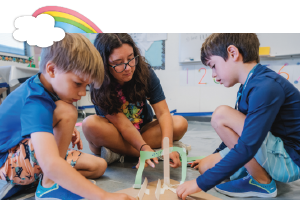3 Fun STEM Projects for Elementary Students

In a recent study of American adults, a vast majority said they enjoyed science and math classes during their education. As we begin raising children of our own, it’s only natural that we share our passion for Science, Technology, Engineering and Mathematics (STEM).
STEM activities aren’t as easy to share as a story or impromptu history lesson, as they often require special materials to complete. Fortunately, we have three STEM projects for elementary students that are playful, engaging and require only common household materials. Whether you’re a parent or a teacher, these activities are excellent opportunities to develop your kids’ STEM skills while having fun together!
#1 Growing Salt Crystals
This Growing Salt Crystals lesson teaches principles such as solubility and changes in states of matter. Keep in mind that it takes a while for the salt crystals to actually form,so you’ll need a few hours of idle time while the mixture slowly solidifies.
To get started, gather:
- A heatproof, clear vessel such as a mason jar
- Regular, iodized table salt
- Water
- A spoon
- A small string
This project involves bringing water to a boil, so you’ll want to keep kids at a close, but safe distance while it’s still hot. To begin:
- Mix a few spoons of salt into boiling water until fully dissolved.
- Pour the saltwater into your jar.
- Tie the string to the center of the spoon.
- Place the spoon on the mouth of the jar so that the string is suspended down into the saltwater.
- Wait.
It may take several hours (or even days) but, eventually, crystals will begin to form around the string; you can explain the crystal formation process to your kids by saying that=salt crystals are soluble in hot water, as the water cools, the crystals will gravitate towards a solid nucleation site (in this case, the string), stick to it and continue to grow.
Different kinds of salts form various crystal structures, so if your kids love this project, you can experiment with Epsom salts, rock salt and any other varieties to discover the unique formations they’ll create.
#2 Turning Milk into Plastic
Keeping with the theme of changes in states of matter, let’s solidify some milk with this Turning Milk Into Plastic experiment—and no, we won’t (technically) be making cheese.
Instead, we’ll be crafting a sort of moldable plastic that kids can shape, build and play with. To start, collect:
- One cup of milk (2% or lower fat works best)
- Four teaspoons of lemon juice
- A strainer
- A spoon
- A microwave
- A heatproof container
- Paper towels
- A mold for your milk plastic to set in—ice cube trays and silicone baking molds work well (Optional)
We’ll be heating a liquid for this experiment, so take the necessary precautions to keep your kids safe. To begin:
- Pour your milk into the heatproof container and microwave until it’s hot. It needs to reach a minimum of 120°F for this experiment to work.
- Add the lemon juice to the milk.
- Stir gently for about a minute as the milk separates into curds and whey.
- Pour the mixture into a strainer (over the sink) and let it drip for several minutes.
- Once the majority of the liquid has dripped through, squish the milk solids between several pieces of paper towel to get the remaining water out.
- Smooth and shape your plastic while it’s still hot. If you want to press it into a mold, do so before it goes cold.
Explain to your children that the plastic forms as a result of a chemical reaction. The acid from the lemon juice alters the protein in the milk (called casein), separating it from the liquids and making it solid. This “plastic” is the base of many cheeses around the world—but we wouldn’t recommend eating it!
#3 Building a Scale
Every object has a measurable mass, and this fun project allows kids to compare different weights against each other. The Building a Scale project also gives them a glimpse into the way items were once weighed before digital scales became the norm.
To make your DIY scale, you’ll need:
- A coat hanger
- String
- Scissors
- Paper or plastic cups
- A doorknob
- Various household objects to weigh—such as figurines, rocks, cutlery and more
Once you have your materials, putting your scale together is a breeze. Simply:
- Use your scissors to punch two holes under the rims of each cup.
- Use even lengths of string to secure both cups to opposite ends of the coat hanger.
- Hang your scale on a doorknob and begin weighing.
Prepare an array of objects and have your kids estimate which will be heavier and which will weigh less. Have them use their knowledge of different materials and their densities to make their assumptions.
Then, explain that scales used to function this way in the past, with one cup filled with a set weight and the other cup loaded until the two sides balanced. For fun, you can have them weigh coins or other small objects against a larger item to try to reach a perfect balance.
Enroll Your Kids in Camp Galileo for a Stimulating, STEM-Filled Summer
Camp Galileo gives kids the opportunity for an exhilarating summer filled with even more STEM fun!
Our acclaimed summer program pulls from the worlds of Science, Technology, Engineering, Art and Mathematics (STEAM), plus collaboration and play-based learning to equip campers with the skills they need to improve our world. Cultivating confident, resilient out-of-the-box thinkers is our goal, as we take all the excitement of a traditional summer camp and add unique, fun and informative activities to elevate your kids’ summer experience. From kindergarten to 8th grade, Camp Galileo provides kids with hands-on, educator-led STEAM activities, outdoor adventures and more. We also provide a Counselor In Training program for 8th-10th graders at select locations.
Summer is just around the corner, so don’t wait. With more than 70 locations across the United States, find a camp near you and enroll your kids today!
Sources:
- Brewer Shelley. “Make Plastic From Milk”. STEAM Powered Family. 8 May 2023. https://www.steampoweredfamily.com/.
- Funk Cary, Parker Kim. “Many Americans say they liked math and science in school, thought about a STEM career”. PEW Research Center. 9 January 2018. https://www.pewresearch.org/.
- Grand Canyon University. “Best Elementary STEM Activities”. GCU. 28 August 2020. https://www.gcu.edu/.
- National Center for Education Statistics. “Mathematics Performance”. Condition of Education. US Department of Education, Institute of Education Sciences. May 2023. https://nces.ed.gov/.
- National Center for Education Statistics. “Science Performance”. Condition of Education. US
Department of Education, Institute of Education Sciences. May 2022. https://nces.ed.gov/.

